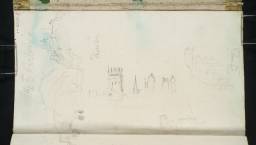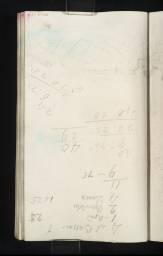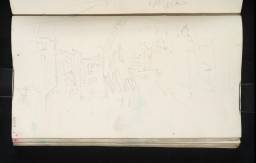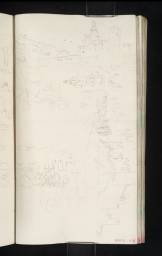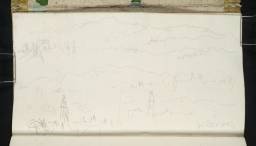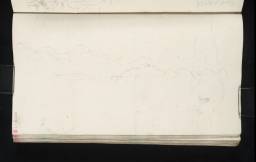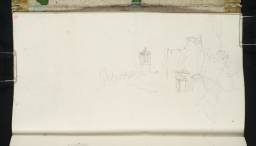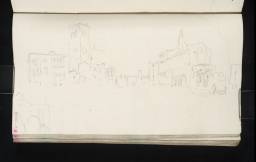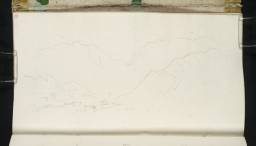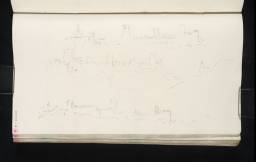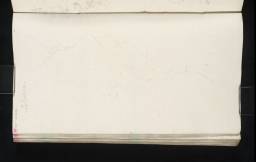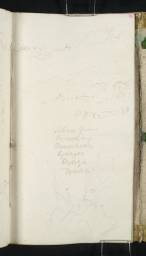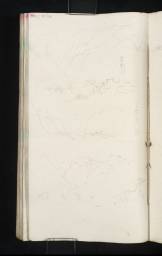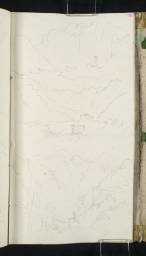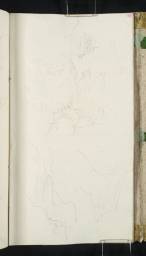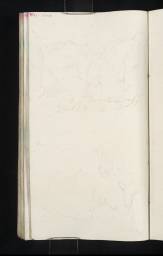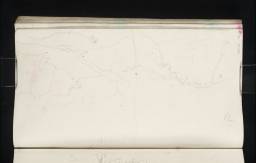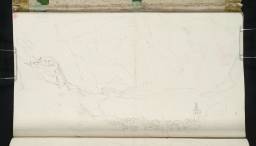Turner Bequest CCCXII 1–100
Sketchbook bound in thin card boards, covered in mottled green paste-paper; flap extending from fore-edge of front cover, folding round page block and a third of back cover; stubs of green ribbon ties secured through front cover, with corresponding intact loop at back
100 leaves of white laid paper, page size 203 x 209 mm; first and last leaves glued at top and bottom edges onto lilac-red laid free endpapers to form pockets
Made by Cartiera Galvani (white leaves) and Pietro Galvani (endpapers) at Pordenone, Friuli-Venezia-Giulia, Italy; various leaves watermarked partially with large crescent moon with face in profile and countermarked ‘C G’; endpapers watermarked ‘P G’
Numbered 401 as part of the Turner Schedule in 1854 and endorsed by the Executors of the Turner Bequest inside back cover (D41112)
Blind-stamped with Turner Bequest monogram on back cover, towards bottom right
Inscribed in pencil ‘CCCXII’ on back cover, bottom right (upside down)
Stamped in black ‘CCCXII’ on front cover, top right
100 leaves of white laid paper, page size 203 x 209 mm; first and last leaves glued at top and bottom edges onto lilac-red laid free endpapers to form pockets
Made by Cartiera Galvani (white leaves) and Pietro Galvani (endpapers) at Pordenone, Friuli-Venezia-Giulia, Italy; various leaves watermarked partially with large crescent moon with face in profile and countermarked ‘C G’; endpapers watermarked ‘P G’
Numbered 401 as part of the Turner Schedule in 1854 and endorsed by the Executors of the Turner Bequest inside back cover (D41112)
Blind-stamped with Turner Bequest monogram on back cover, towards bottom right
Inscribed in pencil ‘CCCXII’ on back cover, bottom right (upside down)
Stamped in black ‘CCCXII’ on front cover, top right
Accepted by the nation as part of the Turner Bequest 1856
Exhibition history
References
This sketchbook was used briefly in Venice, likely for the last two drawings made in the city on Turner’s 1833 visit (folios 2 verso, 3 recto; D31600–D31601), following on from the technically similar Venice book (Tate; Turner Bequest CCCXIV).1 It then charts his route northwards on the return journey, ‘from Venice | up to Trent[?o]’ as noted inside the front cover (D41110), but also considerably further, by way of Bolzano (Bozen), the Brenner Pass, Innsbruck and Augsburg. This route, a little over 200 miles as the crow flies but about twice that by well-established coach routes, included the stretch between Innsbruck and Trento Turner had recently travelled on his way down from Vienna. On that occasion he had continued south to Verona and then eastwards for Padua and Venice; now, in returning initially to Trento, he took a more direct route north-westwards from the coast.
Finberg speculated on Turner’s itinerary in undated MS notes supplementing the individual identifications in his 1909 Inventory:
He came [‘went from Trient’ inserted above] through Verona, & returned there to Trient through Bassano, Levico, and continued from Trento though Bolzano to Innsbruck. | From Innsbruck to Augsburg | ? through Zirl, Partenkirch, Murnau, Weilheim – (?through Munich – prbly not, but through Landsberg, Lechfeld to Augsburg | ? From Augsburg to the Rhine | probably through Wurzburg & Frankfurt to Mainz 41 ¾ m. from A to Frankfurt | abt 36 hours in diligence | Or ?from A. to Lindau or Lake Constance 19 ½ m. by diligence2
The ‘m’ distances here were seemingly taken from guidebooks, signifying the ‘miles’ of the old German system, equating to nearly five English ones.3 In a further MS checklist (albeit in reverse order), Finberg linked the string of towns and cities from Treviso, Turner’s first recorded stop inland from Venice, all the way up to Bolzano: ‘Bolzano | Salorno | S Michele | Trento | Pergine | Caldonazzo | Levico | Borgo | Strigno | Primolano | Valstagna | Bassano | Castelfranco | Treviso’.4 These speculations (albeit not concerning the route beyond Augsburg) complement the published itinerary Finberg set out in 1930’s In Venice with Turner:
VENICE UP TO TRIENT Sketch Book. Having come through Verona from Trento he returns through Treviso (p. 97a), Castelfranco (96a), Bassano, Primolano, Borgo and Levico (88); there are sketches of Trento from the north (38), the Castle from the River (42) and the cathedral (77); numerous sketches at Bolzano and the Castles in its neighbourhood, especially of Firmiano (Sigmundskron) (pp. 23, 23a, 24, 24a, 25, 43a, 45, 45a, 47); and several at Innsbruck (pp. 28, 52, etc.), one from Berg Isel (67a), and one at Unter Schonberg with the marble tablet (35), outside Innsbruck on the road to Brennero. ‘“Venice up to Innsbruck” would be a better title for this book than Turner’s.’5
The scattered page numbers highlight the fundamental difficulty in establishing the locations of the many less topographically distinctive, generic mountainous scenes within the book, as Turner spent roughly two thirds of the journey in Alpine valleys and passes. He worked unsystematically inwards from both ends, as well as returning effectively at random to use up blank pages between existing drawings. There are enough identified subjects to make the overall route clear and logical despite these apparent convolutions,6 as set out more definitively below, and to indicate the places he found of particular interest, or where he had the opportunity to linger.
Until Cecilia Powell’s comprehensive re-ordering of Turner’s later German sketchbooks and related sheets in relation to her 1995 Turner in Germany exhibition at Tate Britain, the other issue with this one (as with numerous others) had been its date, as discussed in the overall Introduction to the tour. In his 1909 Inventory entry, Finberg had placed it at about ‘1837–1841’; he later amended this published date, crossing it out and adding ‘1835’.7 This reflected his thesis that Turner’s second visit to Venice had come in that year, with a ‘return journey through Bassano and Levico, Innsbruck, and the Rhine to Dover’ recorded in Turner Bequest sketchbooks ‘cccxii and cccix’, respectively this one and Dover, Rhine and Innsbruck,8 since redated to 1843.9
Hardy George later published the documentary evidence of Turner’s arrival in Venice on 9 September 1833, as noted in the Introduction to the Venice sketchbook (Tate; Turner Bequest CCCXIV), which he linked to this one as its ‘most likely companion’.10 The Turner scholar C.F. Bell (1871–1966) had annotated the present book’s introductory paragraphs in Finberg’s Inventory: ‘Only one sketch of Venice and in that the Campanile [of San Marco (St Mark’s)] does not appear’.11 As again discussed in relation to the other book, this eventuality would have been an aid in terms of whether or not scaffolding were present around the spire, which only coincided with Turner’s 1819 and 1840 visits. Bell carefully recorded its absence or presence in many instances in his MS notes to Finberg’s accounts; his and Finberg’s own extensive notes in copies of the Inventory (Prints and Drawings Room, Tate Britain) on the subjects of individual drawings are quoted in relevant entries.
As well as labelling some individual pages with place names, Turner made his own notes relating to the unfamiliar early part of his itinerary towards Trento on folios 2 recto, 10 verso and 81 recto (D31599, D31616, D31754). The listing of the overall route which follows12 includes some newly identified subjects only inferred by Finberg from those he recognised. The local Italian and German alternatives are given where appropriate, and an asterisk indicates more than one geographically distinct subject on one page:
Venice: folios 2 verso* and 3 recto (D31600–D31601)
Undated MS note by Finberg (died 1939) in interleaved copy of Finberg 1909, Prints and Drawings Room, Tate Britain, II, opposite p.1004.
See for example preliminary ‘Table F’ in John Murray, A Handbook for Travellers in Southern Germany, London 1837.
Undated MS note by Finberg in interleaved copy of Finberg 1909, Prints and Drawings Room, Tate Britain, II, opposite p.1008.
Undated MS note by Finberg (died 1939) in interleaved copy of Finberg 1909, Prints and Drawings Room, Tate Britain, II, p.1004.
The Brenta Valley including the Valsugana:
Trento (Trent/Trient): numerous views in and around the city in two distinct sequences: see under folio 37 recto (D31669)
The Adige (Etsch) Valley, including today’s Strada del Vino (Weinstrasse) district:
?San Michele: folios 85 verso, 86 recto (D31763–D31764); Salorno (Salurn, where the route passed into Alto Adige/Südtirol): see under folio 82 verso (D31757); Laghetti (Laag): folio 83 recto (D31758); ?Cortina and Magrè (Kurtinig and Margreid): folio 85 recto (D31762); Tarmeno (Tramin) and Egna (Neumarkt): folio 82 recto (D31756); ?Laives (Leifers): folio 88 recto (D31768); Vadena (Pfatten): folio 88 verso (D31769)
The Isarco (Eisack) Valley:
Ponte Gardena (Waidbruck) and Castel Trostburg: see under folio 54 verso (D31704); Chiusa (Klausen) and Sabiona (Säben) Monastery: see under folio 61 recto (D31716); ?Bressanone (Brixen): folio 62 verso (D31719); ? Forte di Fortezza (Franzensfeste): folio 57 verso (D31710); Vipiteno (Sterzing): folio 33 verso (D31662); ?the Brenner Pass: folio 81 recto (D31754)
Austria (Nordtirol):
Schönberg im Stubaital: folio 35 recto (D31665)
Innsbruck: see under folio 17 recto (D31629). Roughly seventy miles on from Bolzano, Turner was noted in the 26 September issue of the Intelligenz-Blatt zum K.K. priv. Bothen von und für Tirol und Vorarlberg, as having arrived at the city on 23 September.14 The ruins of Fragenstein, which stand above Zirl (mentioned in Finberg’s MS notes as transcribed above), about seven miles west of Innsbruck, are seen in some of the pencil drawings on grey paper made around that very date (see Tate D33796, D33843, D33845, D33848, D33851; Turner Bequest CCCXLI 115, 157, 158, 159v, 161) as is the nearby Kalvarienberg church (D33841, D33846, D33852; CCCXLI 155v, 158v, 161v); Zirl’s parish church may be shown on D33840 (CCCXLI 155).
Germany (Bavaria):
Landsberg am Lech: folios 73 recto and verso, and 74 recto (D31738–D31740); Augsburg: see under folio 30 recto (D31655)15
Although in some cases the subject of multiple sketches, none of these places directly inspired any finished paintings or watercolours, but Bolzano appears to have made enough of an impression for Turner to have spent time there on the way out to Venice by a largely different route in 1840; on that occasion he made several colour studies on grey paper, as discussed under D31598. Augsburg was only roughly half way home, and he likely acquired the Rotterdam and Rhine sketchbook there (Tate; Turner Bequest CCCXXII), making further studies of the city before the last leg, by road to the Rhine, and then down the river and its distributaries to Rotterdam by early October.
Finberg recorded John Ruskin’s habitually brief endorsement on a ‘wrapper’ which, like the majority, has not survived: ‘401. Late sketch book of little value. Chiefly Alpine.’16 He also noted ‘on outside of cover, in paint – “6” (?)’,17 which is not now apparent. Unusually, the standard handwritten numbers at the corner of each recto appears in this case to be by C.F. Bell, in black ink over what seem to be very faint (if any) pink smudges, likely signs of the usual red ink numbers, perhaps affected by the 1928 Tate Gallery flood; the same applies to the contemporary Venice sketchbook.
Technical notes
How to cite
Matthew Imms, ‘Venice up to Trento Sketchbook 1833’, sketchbook, May 2019, in David Blayney Brown (ed.), J.M.W. Turner: Sketchbooks, Drawings and Watercolours, Tate Research Publication, March 2023, https://www


